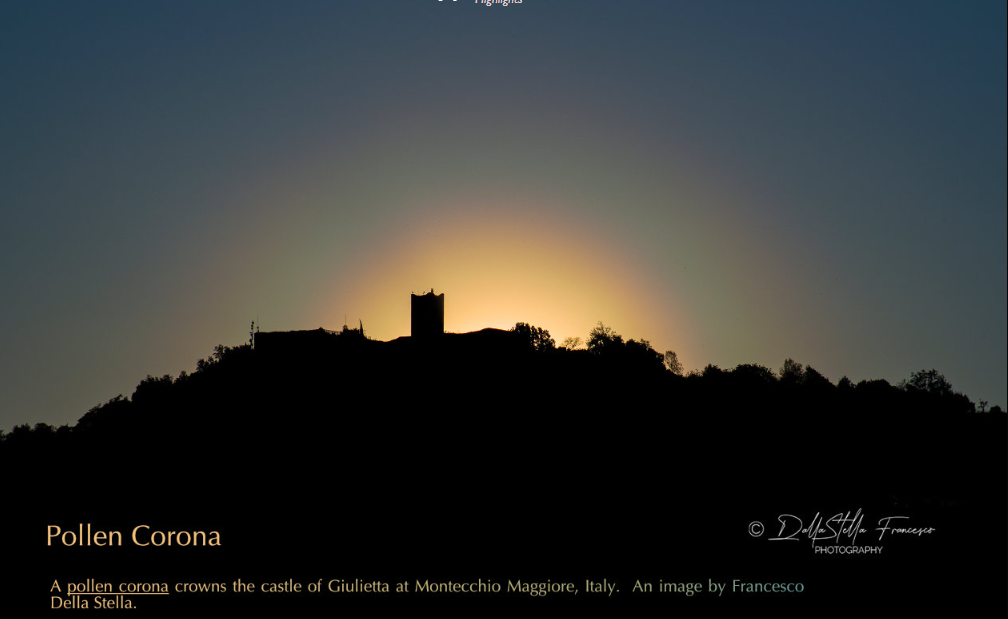Pollen Corona
The Beauty of Pollen Corona
When it comes to atmospheric optics, one phenomenon that captivates both scientists and nature enthusiasts alike is the mesmerizing display of a pollen corona. Unlike ordinary water droplets found in clouds, pollen grains possess a unique quality that allows them to create a sharp and vivid diffraction pattern in the sky. In this article, we will delve deeper into the intricacies of pollen coronae and explore the science behind their enchanting beauty.
The Perfect Symmetry of Pollen Grains
Pollen grains, originating from a specific tree, possess a remarkable uniformity in size and shape. This characteristic plays a crucial role in the creation of a pollen corona. Each grain acts as a miniature diffracting element, causing the sun's rays to scatter and interfere with one another. The result is a stunning diffraction pattern consisting of undiluted colors that adorn the sky.
A Symphony of Colors
One of the most captivating aspects of a pollen corona is its vibrant color palette. The undiluted colors produced by the diffraction of light through pollen grains are a sight to behold. From rich blues and vibrant greens to warm yellows and fiery oranges, the corona paints the sky with a symphony of hues. Each color represents a different wavelength of light that has undergone diffraction, adding to the visual spectacle.
The Limitations of Water Droplets
While water droplets found in clouds also contribute to atmospheric phenomena, they possess certain limitations when it comes to creating coronae. Unlike pollen grains, water droplets come in a range of sizes, leading to broken coronae and iridescence. Additionally, the sizes of these droplets can vary significantly across the angular extent of the corona. Although still spectacular in their own right, water droplets produce coronae with a different visual effect compared to pollen coronae.
Unveiling the Science
To fully appreciate the science behind pollen coronae, we must delve into the principles of diffraction. Diffraction occurs when light encounters an obstacle or passes through a narrow aperture, causing it to spread out and create interference patterns. In the case of pollen coronae, each pollen grain acts as a diffracting element, scattering the incoming sunlight and producing a diffraction pattern in the sky.
Exploring the Phenomenon
The study of pollen coronae goes beyond their visual allure. Scientists use these atmospheric optics phenomena to gain insights into various aspects of our environment. By analyzing the size and shape of pollen grains, researchers can gather valuable information about plant species and their distribution. Furthermore, the presence of pollen coronae can serve as an indicator of air quality, providing clues about the concentration of pollen in a particular area.
Capturing the Magic
Photographers and nature enthusiasts are often drawn to the ethereal beauty of pollen coronae. The intricate patterns and vivid colors make them a captivating subject for artistic endeavors. To capture the magic of a pollen corona, photographers employ various techniques, such as adjusting exposure settings and utilizing polarizing filters to enhance the contrast and saturation of the colors.
A Global Phenomenon
Pollen coronae can be observed in various parts of the world, adding a touch of enchantment to the skies. From Italy's Montecchio Maggiore, where Giulietta's castle is adorned with a pollen corona, to countless other locations across the globe, these atmospheric displays never fail to mesmerize those fortunate enough to witness them. Each instance offers a unique spectacle, with variations in color intensity and pattern intricacy.
Connecting with Nature
Witnessing a pollen corona is not only a visual delight but also an opportunity to connect with the natural world. These awe-inspiring displays remind us of the intricate beauty that exists all around us, even in the smallest of particles. They serve as a gentle reminder of the interconnectedness of all living things and the delicate balance of our ecosystem.
A Window into the Invisible
Pollen coronae provide us with a glimpse into the invisible world of atmospheric optics. Through their stunning visuals and scientific significance, they invite us to explore the wonders that exist beyond our naked eye's perception. By unraveling the secrets of pollen coronae, scientists continue to deepen our understanding of light, diffraction, and the intricate dance between nature and physics that unfolds above our heads. So, the next time you find yourself gazing at the sky, keep an eye out for the magical display of a pollen corona and let it transport you to a world where science and beauty intertwine.

Pollen Corona
A pollen corona crowns the castle of Giulietta at Montecchio Maggiore, Italy. An image by Francesco Della Stella.
Pollen grains from a particular tree are all the same size and shape. That's perfect for making a corona. Each grain diffracts the sun's rays in the same way to give us a sharp diffraction pattern in the sky with undiluted colours.
Ordinary water droplets in clouds are less good. They have a range of sizes. Even worse, their sizes can change dramatically across the corona's angular extent. That gives us broken coronae and iridescence. Still spectacular but in a different way.
Note: this article has been automatically converted from the old site and may not appear as intended. You can find the original article here.
Reference Atmospheric Optics
If you use any of the definitions, information, or data presented on Atmospheric Optics, please copy the link or reference below to properly credit us as the reference source. Thank you!
-
<a href="https://atoptics.co.uk/blog/pollen-corona-2/">Pollen Corona</a>
-
"Pollen Corona". Atmospheric Optics. Accessed on November 26, 2024. https://atoptics.co.uk/blog/pollen-corona-2/.
-
"Pollen Corona". Atmospheric Optics, https://atoptics.co.uk/blog/pollen-corona-2/. Accessed 26 November, 2024
-
Pollen Corona. Atmospheric Optics. Retrieved from https://atoptics.co.uk/blog/pollen-corona-2/.